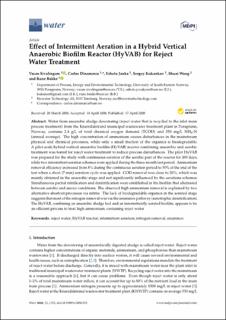| dc.contributor.author | Sivalingam, Vasan | |
| dc.contributor.author | Dinamarca, Carlos | |
| dc.contributor.author | Wakjera, Eshetu Janka | |
| dc.contributor.author | Kukankov, Sergey | |
| dc.contributor.author | Wang, Shuai | |
| dc.contributor.author | Bakke, Rune | |
| dc.date.accessioned | 2020-10-20T13:00:13Z | |
| dc.date.available | 2020-10-20T13:00:13Z | |
| dc.date.created | 2020-10-14T11:38:57Z | |
| dc.date.issued | 2020 | |
| dc.identifier.citation | Sivalingam, V., Dinamarca, C., Janka, E., Kukankov, S., Wang, S., & Bakke, R. (2020). Effect of Intermittent Aeration in a Hybrid Vertical Anaerobic Biofilm Reactor (HyVAB) for Reject Water Treatment. Water, 12(4), 1151. | en_US |
| dc.identifier.issn | 2073-4441 | |
| dc.identifier.uri | https://hdl.handle.net/11250/2683938 | |
| dc.description.abstract | Water from anaerobic sludge dewatering (reject water that is recycled to the inlet main process treatment) from the Knarrdalstrand municipal wastewater treatment plant in Porsgrunn, Norway, contains 2.4 g/L of total chemical oxygen demand (TCOD) and 550 mg/L NH4-N (annual average). The high concentration of ammonium causes disturbances in the mainstream physical and chemical processes, while only a small fraction of the organics is biodegradable. A pilot-scale hybrid vertical anaerobic biofilm (HyVAB) reactor combining anaerobic and aerobic treatment was tested for reject water treatment to reduce process disturbances. The pilot HyVAB was prepared for the study with continuous aeration of the aerobic part of the reactor for 200 days, while two intermittent aeration schemes were applied during the three-month test period. Ammonium removal efficiency increased from 8% during the continuous aeration period to 50% at the end of the test when a short (7 min) aeration cycle was applied. COD removal was close to 20%, which was mainly obtained in the anaerobic stage and not significantly influenced by the aerations schemes. Simultaneous partial nitrification and denitrification were established in the biofilm that alternated between aerobic and anoxic conditions. The observed high ammonium removal is explained by two alternative shortcut processes via nitrite. The lack of biodegradable organics in the aerated stage suggests that most of the nitrogen removal was via the anammox pathway (autotrophic denitrification). The HyVAB, combining an anaerobic sludge bed and an intermittently aerated biofilm, appears to be an efficient process to treat high ammonium containing reject water. | en_US |
| dc.language.iso | eng | en_US |
| dc.rights | Navngivelse 4.0 Internasjonal | * |
| dc.rights.uri | http://creativecommons.org/licenses/by/4.0/deed.no | * |
| dc.title | Effect of Intermittent Aeration in a Hybrid Vertical Anaerobic Biofilm Reactor (HyVAB) for Reject Water Treatment | en_US |
| dc.type | Peer reviewed | en_US |
| dc.type | Journal article | en_US |
| dc.description.version | publishedVersion | en_US |
| dc.rights.holder | © 2020 by the authors. | en_US |
| dc.subject.nsi | VDP::Miljøteknologi: 610 | en_US |
| dc.subject.nsi | VDP::Environmental engineering: 610 | en_US |
| dc.source.volume | 12 | en_US |
| dc.source.journal | Water | en_US |
| dc.source.issue | 4 | en_US |
| dc.identifier.doi | https://doi.org/10.3390/w12041151 | |
| dc.identifier.cristin | 1839467 | |
| dc.source.articlenumber | 1151 | en_US |
| cristin.ispublished | true | |
| cristin.fulltext | postprint | |
| cristin.qualitycode | 1 | |

